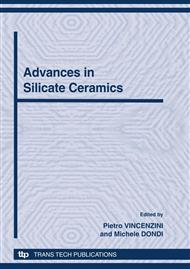[1]
O. Nielsen, US patent 3, 662, 310. (1972).
Google Scholar
[2]
L. Gurevich, US patent 4, 926, 153. (1990).
Google Scholar
[3]
W. Pietsch: An interdisciplinary approach to size enlargement by agglomeration. Powder technology 130 (2003), p.8.
DOI: 10.1016/s0032-5910(02)00218-8
Google Scholar
[4]
Y. Xiao and A.C. Lasaga: Ab initio quantum mechanical studies of the kinetics and mechanisms of quartz dissolution: OH catalysis. Geochimica et Cosmochimica Acta vol. 60 (1996), p.2283.
DOI: 10.1016/0016-7037(96)00101-9
Google Scholar
[5]
J. -A. Kim: Hydration reaction in synthesis of crystalline-layered sodium silicate. Journal of Industrial and Engineering Chemistry Vol. 6 (2000), p.219.
Google Scholar
[6]
R. Singh, in:, Introduction to basic manufacturing processes and workshop technology, edited by New Age International (2006).
Google Scholar
[7]
F Soulier and al: Influence of liquid bridges on mechanical behaviour of polydisperse granular materials. Int. J. Numer. Anal. Meth. Geomech. Vol. 30 (2006), p.213.
DOI: 10.1002/nag.476
Google Scholar
[8]
C.A. Biguelow and al: Physical properties of three sand size classes amended with inorganic materials or sphagnum peat moss for putting green rootzones. Crop Sci. Vol. 44 (2004), p.900.
DOI: 10.2135/cropsci2004.0900
Google Scholar
[9]
J. Bouma and al: Retention of water: basics of soil-water relationships - part II. IFAS Extension (2003).
Google Scholar
[10]
G. Roma and al: Oxygen Self-diffusion in alpha Quartz. Phys. Revue Letters Vol. 86 (2001), p.4564.
Google Scholar
[11]
S. Nakagawa and L.R. Myer: Mechanical and acoustic properties of weakly cemented granular rocks. Lawrence Berkeley National Laboratory (2001).
Google Scholar
[12]
D. Bernache-Assollant and J. -P. bonnet : Frittage: aspects physico-chimiques, Partie 1 : frittage en phase solide. Revue des Techniques de l'Ingénieur (2005).
DOI: 10.51257/a-v1-af6620
Google Scholar
[13]
A.M. Neville, in: Properties of concrete, edited by John Wiley & Sons, New York (1996).
Google Scholar
[14]
D. Bernache-Assollant and J. -P. bonnet : Frittage: aspects physico-chimiques, Partie 2 : frittage en phase liquide. Revue des Techniques de l'Ingénieur (2005).
DOI: 10.51257/a-v1-af6621
Google Scholar
[15]
R.N. Swamy, in: The alkali-silica reaction in concrete. Edited by Backie & Son, Glasgow (1992).
Google Scholar
[16]
W.A. Tasong and al: Aggregate-cement chemical interactions. Cement and Concrete Research Vol. 28 (1998), p.1037.
DOI: 10.1016/s0008-8846(98)00067-2
Google Scholar
[17]
S. Chatterji: Chemistry of alkali-silica reaction and testing of aggregates. Cement and concrete composites Vol. 27 (2005), p.788.
DOI: 10.1016/j.cemconcomp.2005.03.005
Google Scholar
[18]
Z.P. Bazant and A. Steffens: Mathematical model for kinetics of alkali-silica reaction in concrete. Cement and Concrete Research Vol. 30 (2000), p.419.
DOI: 10.1016/s0008-8846(99)00270-7
Google Scholar
[19]
K. Bjorlykke and P.K. Egeberg: Quartz Cementation in Sedimentary Basins. Am. Assoc. Petrol. Geol. Bull. Vol. 77 (1993), p.1538.
DOI: 10.1306/bdff8ee8-1718-11d7-8645000102c1865d
Google Scholar
[20]
G. Bird and al: Silica transport during steam injection into oil sands. 1. Dissolution and precipitation kinetics of quartz: new results and review of existing data. Chemical geology Vol. 54 (1986), p.69.
DOI: 10.1016/0009-2541(86)90072-0
Google Scholar


